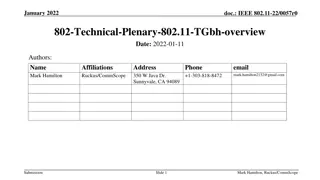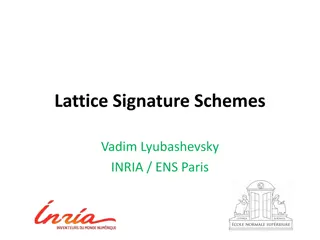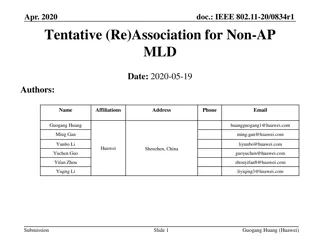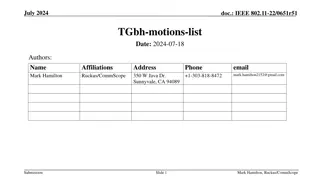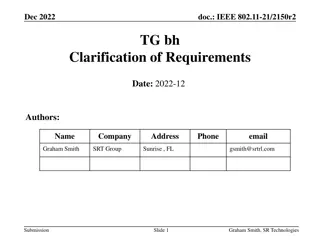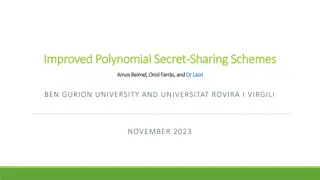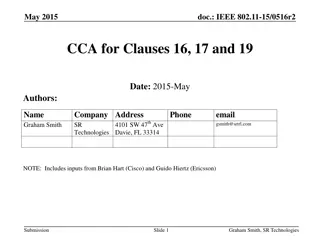IEEE 802.11-22/0955r0 TGbh Pre-association Schemes Exploration
The document explores the pre-association schemes NGID, MAAD, and IRM within the IEEE 802.11-22 standard. It discusses how the schemes operate, comparing RRCM to MAAD and IRM, and addresses the use of Probes and MAC addresses in pre-association scenarios. The presentation clarifies the allocation of MAC addresses for STAs, emphasizing the importance of using random MAC addresses for broadcast and directed probes to maintain privacy and security.
Download Presentation

Please find below an Image/Link to download the presentation.
The content on the website is provided AS IS for your information and personal use only. It may not be sold, licensed, or shared on other websites without obtaining consent from the author.If you encounter any issues during the download, it is possible that the publisher has removed the file from their server.
You are allowed to download the files provided on this website for personal or commercial use, subject to the condition that they are used lawfully. All files are the property of their respective owners.
The content on the website is provided AS IS for your information and personal use only. It may not be sold, licensed, or shared on other websites without obtaining consent from the author.
E N D
Presentation Transcript
July 2022 doc.: IEEE 802.11-22/0955r0 TG bh Pre-association in TGbh - Probes Date: 2022-07 Authors: Name Company Address Phone email Graham Smith SRT Group Sunrise , FL gsmith@srtrl.com Submission Slide 1 Graham Smith, SR Technologies
July 2022 doc.: IEEE 802.11-22/0955r0 Intro 22/0908r1 considered three schemes NGID (device ID), MAAD, IRM All schemes can exist together with no negotiations, calculations or computations MAAD and IRM are schemes to meet the pre-association Use Cases. 22/0933r2 compared the RRCM scheme to MAAD and IRM RRCM can derive multiple addresses used for probes and association Note: So can MAAD and IRM. Questions were made about how Probes and MAC addresses were used with these pre-association schemes This presentation discusses how Probes are used and if different addresses are required. By trying to cover this is detail there is a danger that it will seem that this is a complex item. It is not, but I am trying to cover all the areas and questions that inevitably will come up. Submission Slide 2 Graham Smith, SR Technologies
July 2022 doc.: IEEE 802.11-22/0955r0 MAAD IRM RRCM Outlines MAAD AP sends a new MAC address (in 4-way HS msg 3) every association and STA uses that as TA in the next association IRM STA sends a new MAC address (in 4-way HS msg 2) every association and STA uses that as TA in the next association IRM was proposed as some members indicated they wanted an option for the STA to choose the MAC address, rather than it being allocated for them RRCM STA sends a seed (16 octets in 4-way HS msg 2) in each association, then AP and STA, using PTK, independently generate one or more MAC addresses to be used in next association. RRCM can generate that multiple addresses from same seed. Note Nothing stopping MAAD or IRM from allocating more than one address. Submission Slide 3 Graham Smith, SR Technologies
July 2022 doc.: IEEE 802.11-22/0955r0 Broadcast Probes Active Broadcast Looking for networks in range. No reason why STA should use the identifiable address, would use an RMA (random MAC address) STA may use broadcast probes to find a network BUT STA is ill-advised to use an identifiable address in a broadcast probe no requirement to do so, anyhow, and why would it? Submission Slide 4 Graham Smith, SR Technologies
July 2022 doc.: IEEE 802.11-22/0955r0 Active Directed Probes Looking for a specific AP/network. (Maybe already found using broadcast) A STA probing with same TA over time and area is definitely trackable, so don t do it Why use identifiable address? Why even use a fixed address? Definitely discouraged and not required. Is there ever any reason to use an identifiable TA in a directed Probe? Are there APs that will not respond if they don t know who it is? Use Cases for steering? If STA knows it is in vicinity of the network, then probing with identifiable TA is OK. Submission Slide 5 Graham Smith, SR Technologies
July 2022 doc.: IEEE 802.11-22/0955r0 Probing in vicinity of Network If in the vicinity of the network*, then is it trackable? If STA probes with same address as it Associates with there is no problem? All listener knows is that a STA probed and associated so what? Listener will NEVER see that address AGAIN in that area, AND Listener will NEVER see that address AGAIN if monitoring a large area. (If it did, it is highly probable it is a different STA anyway). The allocated random MAC address contains no identity to STA Not even a need to use a second identifiable address. *Determined by Passive or active (with RMA) scanning, or directed by network for steering purposes Slide 6 Submission Graham Smith, SR Technologies
July 2022 doc.: IEEE 802.11-22/0955r0 Is there a need for Multiple Addresses? RRCM s can generate a number of addresses each time. (Needs further computations, KDE seed plus counter 18 octets) e.g., RMA1 in probe request frame for 3 hours then use RMA2, then use RMA3 in other frames (Association) No rule defined MAAD and IRM could simply send 2 (or 3) addresses each time - (still only 12/18 octets) no computations. STA could then use one address for probes and other for associations. BUT WHY? Is the overhead worthwhile? Let s look at the Use Cases Submission Slide 7 Graham Smith, SR Technologies
July 2022 doc.: IEEE 802.11-22/0955r0 Use Case 4.1 Pre-Association client steering Before connecting to the 802.11 network, the phone scans to discover the available APs, by sending Probe Requests. infrastructure monitors the signal levels at multiple APs and bands determines which AP and band will provide the best service, and steers the client to that AP. Discussion: 1. STA could/should use an RMA for the probes in order to find the network, 2. STA knows it is in vicinity so probing with identifiable TA is now not a problem. 3. No real need for a different TA for the probes. . Submission Slide 8 Graham Smith, SR Technologies
July 2022 doc.: IEEE 802.11-22/0955r0 USE Case 4.2 During association (parental controls) devices to be recognized when attaching to the 802.11 network and control access to Internet content based on the user unknown devices need to be distinguishable from one of the approved devices. Discussion STA recognized by MAC Address in Association Request. AP can decide whether to respond or not etc. No need for multiple addresses. No specific probes required in this Use Case. Submission Slide 9 Graham Smith, SR Technologies
July 2022 doc.: IEEE 802.11-22/0955r0 Use Case 4.8 - Infrastructure if the client uses the stable MAC address when probing, the infrastructure can help steer the client across both APs and bands, to give the entire network better experience. The associated AP sends a Beacon request frame to instruct the STA to send the probing on the target APs operating channel Discussion In this case STA knows it is in the vicinity , as it is instructed to send probes, hence This is not a problem, as already noted, probing and associating using same address in one vicinity, is not trackable. If a STA is in an area of a network, then no real benefit to a third party knowing that. The STA will return with a different address, and listener has no idea who it is. Submission Slide 10 Graham Smith, SR Technologies
July 2022 doc.: IEEE 802.11-22/0955r0 Use Case 26 Vitual BSSID moves from AP to AP within an ESS, to manage the client transitions. The device is recognized by the APs in multiple-AP infrastructure via its MAC address in the probe request frame, so that the APs generate a unique BSSID for the device to set up wireless connection. Discussion Requires identifiable address in probe and associations (I think). No problem as this is the same vicinity condition. If you really, really want 2 addresses, this particular network could simply allocate 2 addresses using MAAD (way easier than generating 2 RMAs with RRCM). The network knows what it wants, so MAAD would be used here. Follow the user. A given client device is assigned a generated BSSID. That BSSID Submission Slide 11 Graham Smith, SR Technologies
July 2022 doc.: IEEE 802.11-22/0955r0 ANQP ANQP is used by a STA to find out what services are offered and if it wants to connect. Pre-association identification may be useful Offers based on knowledge of who STA is But mainly post association ID (Device ID useful here) so could associate with any RMA. Not clear if this is a pre-association case at all. Aside: STA has been there before, might use ANQP to see what s on offer? But doubtful. It would simply associate. Anyhow, do not see need for different identifiable addresses in GAS frames and association. (Same tracking argument as previous) Submission Slide 12 Graham Smith, SR Technologies
July 2022 doc.: IEEE 802.11-22/0955r0 Probe rules General rule is to use passive probing Broadcast Active probes can be used when simply looking. Hence should use RMA. Direct probes should still as a rule use RMA. Probing for a network over time and area should never use same TA even if an RMA. If STA knows it is in the vicinity of known AP/network it could use the identifiable address IF it wants the network to recognize it, steer it, BEFORE Association Request. STA could use directed probes with identifiable address No real problem even if same address used for association. Listener notes a STA is probing and associating BUT NEVER sees that address again so nothing to track! Submission Slide 13 Graham Smith, SR Technologies
July 2022 doc.: IEEE 802.11-22/0955r0 Conclusions - 1 General rule use RMAs in probes. The important point is that even if a STA used the same (allocated) address in probes and association, while in vicinity of AP, still not trackable. Address changes next time STA comes back and associates OR goes anywhere else. Address changes every association. Can t see any good reason to have multiple recognizable addresses allocated. Submission Slide 14 Graham Smith, SR Technologies
July 2022 doc.: IEEE 802.11-22/0955r0 Conclusions - 2 22/0908r1 showed how Device ID, MAAD and IRM simply co-exist, complementing each other and allowing the AP to either: allow the STA to choose (AP Supports Device ID, MAAD and IRM) or not, (AP only supports Device ID and MAAD). provides full flexibility with pre-association plus ID recognition The MAAD MAC or IRMA work just fine and are secure and untrackable even if used with directed Probes in identified Use Cases. Submission Slide 15 Graham Smith, SR Technologies







